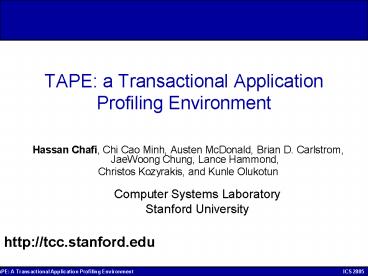TAPE: a Transactional Application Profiling Environment
1 / 18
Title:
TAPE: a Transactional Application Profiling Environment
Description:
Hassan Chafi, Chi Cao Minh, Austen McDonald, Brian D. Carlstrom, JaeWoong Chung, Lance Hammond, ... Need correct and fast parallel executables ... –
Number of Views:26
Avg rating:3.0/5.0
Title: TAPE: a Transactional Application Profiling Environment
1
TAPE a Transactional Application Profiling
Environment
- Hassan Chafi, Chi Cao Minh, Austen McDonald,
Brian D. Carlstrom, JaeWoong Chung, Lance
Hammond, - Christos Kozyrakis, and Kunle Olukotun
- Computer Systems Laboratory
- Stanford University
http//tcc.stanford.edu
2
Optimizing Parallel Performance
- CMPs are here but parallel programming is still
difficult - Need correct and fast parallel executables
- Transactional memory simplifies correct parallel
programming - No locks
- Speculative parallelization
- The Issue is now performance tuning
- TAPE a system for performance profiling of
transactional applications - Expressive tracks all performance bottlenecks
- Accurate identifies bottleneck location in
source code - Easy to use leads to optimal performance in few
tuning steps - Low overhead negligible area performance cost
- TAPE allows for continuous profiling, even on
production runs
3
TCC Architecture for Transactional Execution
Transactions Start
Transaction Control Bits Read, Modified, etc
Request Commit Token
Write Buffer
Commit
Commit Control
TAPE HW
Commit
Transaction Timeline
4
Out-of-the-box TCC Performance
Ideal Time
- Initial parallelization is quick and easy
- Performance tuning is critical
5
Performance Bottlenecks
- Dependency violations
- Due to speculative nature of execution
- Buffer overflows
- Transactions state does not fit in cache
- Workload imbalance
- Transactions are assigned disproportionate amount
of work - Transactional API overhead
- Overhead of starting, committing, and aborting
transactions
6
Dependency Violations
Time
Commit
CPU 1
Write X
Restarts Transaction
CPU 2
Read X
Useful
Arbitrate commit
Idle
Violations
7
Buffer Overflows
Time
Commit
Overflow
Overflow
CPU 1
CPU 2
Commit
Useful
Arbitration Commit
8
Initial Performance Results - 8 processors
Ideal Time
9
Outline
- Motivation
- TAPE system overview
- Example Violation Profiling
- Information gathering and filtering
- Using profile information for optimizations
- Evaluation
- Conclusions
10
Key Insights
- Leverage hardware for transactional execution
- Already monitoring everything
- TAPE operations can be amortized at commit time
- Repeatability of bottlenecks
- Critical performance bottlenecks occur repeatedly
- Data aggregation saves space without losing
accuracy - TAPE automatically filters out infrequent
bottlenecks
11
TAPE System Overview
- Online Hardware
- Each CPU gathers profile data in private buffers
- Bottlenecks aggregated over multiple occurrences
- Infrequent bottlenecks filtered out
- Data periodically flushed to pre-allocated memory
regions - Offline Software
- Combine information from all CPUs
- Rank bottleneck by cost
- Format profiling output relate data to source
code
12
Profiling Violations
CPU 1
CPU 2
- CPU-1 writes address X
- CPU-2 read address X
- CPU-1 commits first
- CPU-2 detects violation on X
- Inserts entry in Transaction Violation Buffer
- CPU 2 restarts transaction
- Re-reads address X
- Sends read PC2 to TVB
- CPU 2 commits
- Most costly violations flushed to Period
Violation buffer - Others may get evicted
- PVB can be flushed periodically
Write X
Core
Read X
CPU 2
Violation
Violation Detection
Read x
Network
Commit
Wasted Work
Read PC
TPC
Object addr
PCt
X
500
PC2
13
Example of Interaction with TAPE
- 1 int data load_data() / input
- 2 int i, buckets101, sum 0
- 3
- 4 t_for_n (i 0 i lt 10000 i 500)
- 5 sum datai
- 6 bucketsdatai
- 7
- 8
- 9 print_buckets(buckets) / output /
4 t_for_n (i 0 i lt 10000 i 50)
5 pSumTCC_getMyID() datai
Violations
8 for i 0 to num_procs sum pSumi
14
Evaluation Methodology
- 8-core CMP processor
- Bus interconnected to shared L2 cache
- Transactional buffering in private L1 caches (32
Kbytes) - Execution driven simulation with accurate
contention modeling - Applications SPEC2K FP and SPLASH-2 benchmarks
- See ASPLOS04 for transactional programming
details - Questions
- Ease of performance tuning with TAPE?
- TAPE buffer size requirements
- TAPE performance overhead
15
Performance Improvements for 8 Processors
Ideal Line
- A maximum of two steps were required to fully
optimize applications - The programmer is directed to the source of the
bottlenecks in the actual code
16
The Cost of TAPE
- Low Chip area cost
- Proposed design point requires less than 5K SRAM
bits, and 244 CAM bits per core - Less than 1 of overall chip area
- Low performance impact
- Maximum slowdown of only 1.84 (Average was
0.28) - Allows for continuous profiling, even on
production runs - Maximum BW usage was 0.11
- Memory Usage
- On average only 1MB/hr of data generated
17
Conclusions
- TAPE a profiling system for transactional
applications - Support easy performance tuning
- Complement correctness benefits of transactions
- Key features
- Expressive tracks all performance bottlenecks
- Accurate identifies bottleneck location in
source code - Easy to use leads to optimal performance in few
tuning steps - Low overhead negligible area performance cost
- Allows for continuous profiling, even on
production runs
18
- Thanks For listening
- http//tcc.stanford.edu































